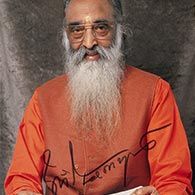Inspired by the 4th and the 18th Chapter of the Geeta, Swami Chinmayananda initiated Jnana Yagnas. Today, Chinmaya Mission is synonymous with Geeta Jnana Yagna. Many organisations have adopted this initiative.
Swami Chinmayananda used to call this as an Open Air University as it required intense and serious study. This is a systematic form of study and not simply a one-time lecture. He would insist on punctuality, attentiveness and reflection from the attendees.
What is a Jnana yagna
In a Yajna, Lord Fire is invoked in the sacrificial trough and into it are offered oblations by the devotees. From this analogy, the term Jnana Yajna or Sacrifice-of-Knowledge has been originally coined and used in the Geeta. Study of the Scriptures and regular contemplation upon their deep significances kindle the "Fire-of-Knowledge" in us and into this the intelligent seeker offers, as his oblation, his own false identification, negative tendencies & ignorance. This is the significance of the metaphorical phrase Jnana Yajna.
In the Geeta Jnana Yagnas, the Time-tested knowledge of the Subjective Science of Spirituality is introduced to people from all backgrounds without any distinctions and they get inspired to live a higher way of life, thus empowering themselves, the society & the world at large.
Knowledge Sharing, Jnana-Seva, Spiritual Sadhanas, Team-work, influencing leaders, mass outreach, igniting the spiritual spark and cultural revival are other aspects of Jnana yagnas which make it most effective.
Jnana Yagnas are the first step in the grand vision of cultural revival that Swami Chinmayananda had.
As one completes the Jnana Yagna features, on the right is the entrance of OM Dhyanaagaar/Om Meditation Room which is below the BMI installation.
More Info
1. what is a Jnana yagna
In a Yajna, Lord Fire is invoked in the sacrificial trough and into it are offered oblations by the devotees. From this analogy, the term Jnaana Yajna or Sacrifice-of-Knowledge has been originally coined and used in the Geeta. Study of the Scriptures and regular contemplation upon their deep significances kindle the "Fire-of-Knowledge" in us and into this the intelligent seeker offers, as his oblation, his own false identification, negative tendencies & ignorance. This is the significance of the metaphorical phrase Jnaana Yajna.
2. Knowledge Sharing
In Geeta Jnana Yagnas, Time-tested knowledge of the Subjective Science of Spirituality is introduced to people from all backgrounds without any distinctions and they get inspired to live a higher way of life, thus empowering themselves, the society & world at large. Each one has a scriptural text book and learns it systematically verse by verse. Swami Chinmayananda insisted on scriptural texts so that these are made available to everyone and also the depth of the scriptures and our time-tested culture is known to all.
3. Jnana Seva There are two types of service – Service of the effects & Service of the Cause.
If I clean the streets, it is service of the effect, which is pollution. If I teach someone about cleanliness and inspire them not to litter, it is service of the cause i.e removing ignorance of importance of cleanliness.
Building schools, hospitals, orphanages, feeding the poor etc. is serving the effects & it is important. Yet one’s incompleteness remains. Deeper is the sharing of Self-Knowledge because it removes the root cause of sorrow – Ignorance & incompleteness. Self-Knowledge is the most powerful form of empowerment, which leads one to fulfilment & freedom.
4. Spiritual Sadhanas
Swami Chinmayananda also integrated spiritual Sadhanas in the Geeta Jnana Yagnas so that one could apply the principles of Vedanta practically. Akhanda-Naam sankirtan of Hare ram hare ram ram ram hare hare, hare Krishna hare Krishna Krishna Krishna hare hare, havans, visit to temples(Yatra), Dip in sacred rivers(Avabhrita Snaanam), meditation on Om, japa of mantras etc. prepare the mind to live the Vedantic Vision of Life.
5. Yagna as a team work
Yagnas are symbolic of coming together sinking all differences, for a selfless cause, contributing one’s best for the benefit of the society. Geeta Jnana Yagnas foster the spirit of teamwork in the community for the selfless service of Knowledge-Empowerment
6. Influencing Intellectuals
Geeta Ch.3 Verse 21 says – As the Leaders in a society act, so the others follow. Standards set by them are imitated by all. Swami Chinmayananda’s vision was to use a Top-Down approach. President of India, Political dignitaries, Industrialists and many intellectuals used to inaugurate, attend, organise a Jnana yagna and were transformed. The Intellectuals of the country got a direction and pride about their culture and the country. They in turn would influence the masses
7. Mass outreach
Along with the intellectuals, the masses also were attending the talks in thousands. Even today, on an average we reach out to atleast 30,000 people everyday through JnanaYagnas. After Chinmaya Mission, many organisations adopted this method to reach the knowledge to the masses. Jnana Yagna is even now one of the most important activities of Chinmaya Mission
Swami Chinmayananda did more than 560 Geeta Jnana Yagnas. Some of his early yagnas were for 100 days. Later on it became 5-7 days.
8. Spark – just the beginning
Swami Chinmayananda ignited the spark of Self Knowledge through the Jnana yagnas which promote Manan-Sadhana(reflection on scriptures) for the speaker and also Shravan-Sadhana(Listening to Scriptures) for the audience.
To transform the spark into a blazing fire, one has to study & do sadhana regularly. Geeta Jnana Yagnas led to the formation of regular weekly study groups where seekers meet once a week and study a systematic scheme of books to get introduced to Vedanta and gain clarity.
Chinmaya Mission as an organisation started due to the study group members who wanted to continue to study intensely even after the jnana yagnas and live a higher way of life.
9. Cultural Revival Philosophy is the basis of every culture. The Hindu culture can revive and assert its glory only when it is nurtured and nourished by the philosophy of India which is contained in the Upanishads. Jnana Yagnas are the first step in the grand vision of cultural revival that Swami CHinmayananda had. Sandeepany Sadhanalaya, Revival through books & commentaries, Grassroot activities & social service projects are the other four steps.
As one completes the Jnana Yagna features, on the right is the entrance of OM Dhyanaagaar/Om Meditation Room which is below the BMI installation.



